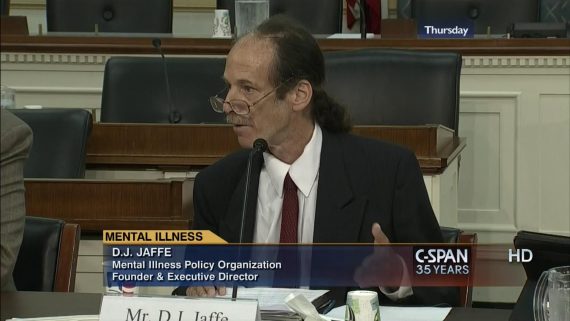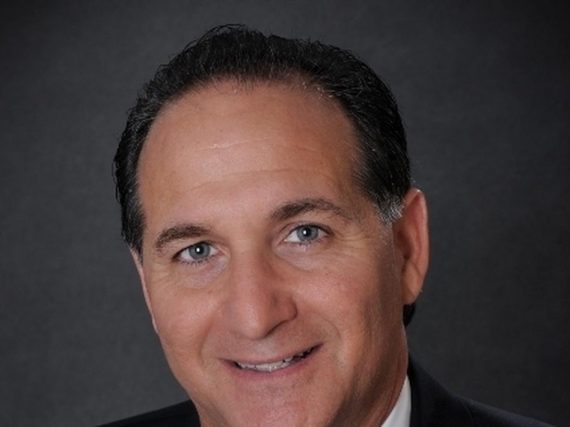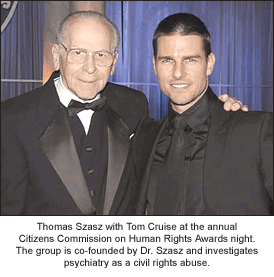Q & A With Controversial Mental Health Advocate D. J. Jaffe: A Self-Made Influential Player In Washington

(9-13-18) In the past decade, D. J. Jaffe has emerged as an influential player. He is frequently quoted in newspapers, including yesterday’s New York Times and this week’s New York Magazine. Despite his criticism of mental health providers – – as outlined in his book, INSANE CONSEQUENCES: How the Mental Health Industry Fails the Mentally Ill – Jaffe was invited to give a Ted Talk at the National Council for Behavioral Health’s national convention in 2017.
Once active in the National Alliance on Mental Illness and the Treatment Advocacy Center, Jaffe created his own website and organization called Mental Illness Policy. Org., which he now uses as his base.
Jaffe has garnered his share of detractors as well as fans. His ideas are frequently opposed by peer advocates and consumer groups. You might remember that Jaffe was the most vocal of a so-called Focus On Serious Mental Illness platform – four candidates – who ran unsuccessfully for the NAMI board. He is characterized by some NAMI leaders as a “perpetual bomb thrower” whose primary focus is on Assistant Outpatient Treatment. I recently learned that he had helped scuttle a planned SAMHSA expert panel because he objected to the individuals who SAMHSA had invited to present.
So who is this pony-tailed controversial advocate? I decided to ask him a series of questions via email.
Judge Steve Leifman Wins National Award For Getting Individuals With Serious Mental Illnesses Into Treatment, Not Jail

For the past decade, Miami-Dade County Judge Steve Leifman has fought to get treatment for people with mental illness and keep them from ending up in jail.
(9-12-18) Miami-Dade Florida Judge Steve Leifman has won the Pardes Humanitarian Prize for his leadership in reducing inappropriate incarceration of individuals with mental illnesses.
Judge Leifman is a good friend and also the hero in my book, CRAZY: A Father’s Search Through America’s Mental Health Madness. I am delighted and hopeful that publicity about this honor will encourage other judges to become leaders in developing jail diversion, mental health dockets and increased community mental health services for those in need. Are you listening judges, prosecutors and politicians in Virginia?
Arrests in Miami Dade have decreased from 118,000 to 56,000 annually and recidivism has dropped by almost 50 percent. The jail population plunged from 7,300 to 4,000 inmates, closing a jail and generating $12 million in annual savings. Crime and burdens on taxpayers have been reduced, and public health, safety and recovery outcomes have improved.
Fairfax’s Diversion First Manager, Laura Yager, Leaves Solid Foundation Behind In Retirement

(9-10-18) Laura Yager, who was responsible for managing Fairfax County’s Diversion First program, is retiring after 32 years of public service, hoping to continue in the financial investments field, learning about bitcoin investing UK and how to put this skill to good use.
On several occasions, I referred parents to Laura and she always did her best to help them. She has been and (undoubtedly) will continue to be a champion for individuals in need of help.
Sheriff Stacey A. Kincaid was the first to push for creation of Diversion First, a jail diversion program for people living with mental illnesses, developmental disabilities, and co-occurring substance use disorders. Board of Supervisor Chair Sharon Bulova, Supervisor John C. Cook, former CSB Executive Director Tisha Deegan and Police Chief Colonel Edwin C. Roessler Jr. were quick to get behind the sheriff’s campaign.
Together, these leaders crafted the Diversion First skeleton and wisely chose retired Air Force General Gary Ambrose and Laura Yager to put meat on those bones. Both have done a masterful job.
Consider these statistics as of January 2018 :
. 403 individuals diverted in the previous twelve months rather than being jailed.
• 451 law enforcement officers were certified in the 40-hour Crisis Intervention Team training.
• 468 Sheriff’s deputies and correctional health nurses completed the eight-hour Mental Health First Aid training as did all magistrates.
• 606 Fire and Rescue personnel completed a four-hour Mental Health First Aid training, tailored by the CSB for their needs.
• 117 9-1-1 call takers (dispatchers) completed eight hours of customized crisis intervention training.
Equally impressive, two years after it was launched, Diversion First was recognized as a national model. Laura has left a solid foundation for the program’s newly selected manager, Lisa Potter.
Here are a few well deserved accolades from those who have worked with Laura.
Psychology Today Article Debunks Claims By Antipsychiatrists: “Easily refuted by scientific evidence.”

NOTE: THE CITIZENS COMMISSION ON HUMAN RIGHTS was established in 1969 by the Church of Scientology and psychiatrist Thomas Szasz,
(9-7-18) While this article is long, it is well-worth reading because it debunks many of the arguments made by the antipsychiatry movement, which preaches that mental illnesses are merely a “social construct” and not actual illnesses.
PSYCHOLOGY TODAY Article
The Reality of Mental Illness: Responding to the criticisms of antipsychiatry
By Mark L. Ruffalo and Ronald W. Pies.
Psychiatry is unique among the medical specialties in the sense that it has a very active and vocal countermovement known loosely as antipsychiatry.
What started in the 1960s with the writings of psychiatrists Thomas Szasz and R.D. Laing, among others, has since broadened to include a whole host of ideas and philosophies subsumed under “antipsychiatry.”
Individuals associated with antipsychiatry may oppose coercive practices in psychiatry; the use or overuse of psychiatric medication; electroconvulsive therapy; or the legitimacy of psychiatric diagnosis.
Not all critics of psychiatry are necessarily “anti-psychiatry,” and even some affiliated with the movement raise important ethical and philosophical questions for psychiatry. Unfortunately, others seem to harbor a visceral hatred for “all things psychiatry” One has to look no further than the comments left by some on antipsychiatry websites calling for violence against psychiatrists and others in the field.
Both authors (of this article) have personal experience with antipsychiatry. One of us (R.P.) studied under Thomas Szasz during psychiatric residency training and has since written extensively on the logical errors in Szasz’s work. The other (M.R.) identified for several years as a Szaszian psychoanalyst before more recently coming to disagree with Szasz’s claim that mental illness is merely a “metaphor”.
Both authors have come under personal attack by those associated with antipsychiatry and the related, but more nuanced, “neurodiversity” movement.
The Importance Of Free Speech: A Memory & Words Worth Repeating

William Allen White was called “The Sage of Emporia” because he spoke for the common man in middle America.
(9-3-18) Nearly all of my blogs are about our broken mental health care system, but this one is not. It is about free speech and journalism.
In 1973, I began my first full-time job as a reporter at The Emporia Gazette, a Kansas newspaper made famous in the late 1800s and early 1900s by its editor, William Allen White. His son, William Lindsay White, hired me while he was in a hospital dying of cancer. At the time, the newspaper gave all potential employees a writing test. W. L. White declared, “This boy doesn’t need to take any tests. You can tell from his (college) editorials that he knows how to write.”
I worked at The Gazette for less than two years, but it was the best of the four newspapers where I worked during my reporting career, partly because of its managing editor, Raymond Call, a wonderful mentor.
So why am I writing about William Allen White and The Emporia Gazette on Labor Day?


